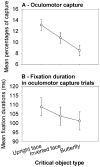Oculomotor guidance and capture by irrelevant faces
- PMID: 22506033
- PMCID: PMC3323541
- DOI: 10.1371/journal.pone.0034598
Oculomotor guidance and capture by irrelevant faces
Abstract
Even though it is generally agreed that face stimuli constitute a special class of stimuli, which are treated preferentially by our visual system, it remains unclear whether faces can capture attention in a stimulus-driven manner. Moreover, there is a long-standing debate regarding the mechanism underlying the preferential bias of selecting faces. Some claim that faces constitute a set of special low-level features to which our visual system is tuned; others claim that the visual system is capable of extracting the meaning of faces very rapidly, driving attentional selection. Those debates continue because many studies contain methodological peculiarities and manipulations that prevent a definitive conclusion. Here, we present a new visual search task in which observers had to make a saccade to a uniquely colored circle while completely irrelevant objects were also present in the visual field. The results indicate that faces capture and guide the eyes more than other animated objects and that our visual system is not only tuned to the low-level features that make up a face but also to its meaning.
Conflict of interest statement
Figures



References
-
- Corbetta M, Shulman GL. Control of goal-directed and stimulus-driven attention in the brain. Nat Rev Neurosci. 2002;3:201–215. - PubMed
-
- Theeuwes J. Top-down and bottom-up control of visual selection. Acta Psychol. 2010;135:77–99. - PubMed
-
- Theeuwes J. Perceptual selectivity for color and form. Percept Psychophys. 1992;51:599–606. - PubMed
-
- Theeuwes J, Kramer AF, Hahn S, Irwin DE. Our eyes do not always go where we want them to go: capture of the eyes by new objects. Psychol Sci. 1998;9:379–385.
-
- McKone E, Kanwisher N, Duchaine BC. Can generic expertise explain special processing for faces? Trends Cogn Sci. 2007;11:8–15. - PubMed

